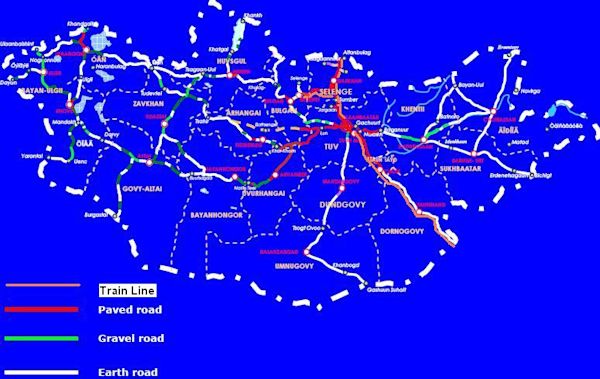Mongolia’s transportation infrastructure and how it influences micro businesses
November 8, 2010
By Amber Barger, KF12, Mongolia.
Mongolia is a landlocked country spanning 1,564,116 sq km, slightly smaller than Alaska. It’s situated between Russia and China. The main forms of transportation available from international destinations are flights from Russia, China, Korea, and Japan and the train route from Russia and China. Domestic flights, the train route and transport by road are options within Mongolia.
Small business owners normally don’t have the money to fly to and from Ulaanbaatar, this luxury is usually only attainable for government officials, foreigners, and wealthier urban Mongolians. I checked a website of a domestic air carrier, Eznis, and the cheapest one way flight from Ulaanbaatar to Khovd province is $273 USD! If a person took a public bus from Ulaanbaatar to Khovd province, the trip would take two full days of traveling and cost $40 USD. The distance from Ulaanbaatar to Khovd is about 980 miles.
From my experience interviewing micro and small businesses, I’ve learned that many of the small businesses import their goods from China. Although, some upscale businesses will import goods from Korea, Japan, Russia, or America, possibly from family members living there. Business owners travel to Ereen, a town on the border with China to purchase equipment, materials, and goods needed to run their business. The owners then take the train from Ereen to Ulaanbaatar, the capital of Mongolia. From there, the goods are transferred to a public bus, truck, or van to transport the goods across rural Mongolia. Many loans listed on Kiva.org mention the borrower’s intention to purchase goods from Ereen, China.
In order to transport goods on the train line from Ereen to Ulaanbaatar, it costs about $15 USD per 200 pounds. Enkhtuya, a Kiva borrower I interviewed, owns a hardware store in Ulaanbaatar. She said that about every five weeks she travels to Ereen to buy supplies and on each trip she spends about $100 USD to transport the goods. My experience living in Arvaikheer, Uvurkhangai was similar, some of the small entrepreneurs I worked with traveled to Ereen about every six weeks to buy supplies for their business.
The micro businesses had less than five employees, and sometimes only a couple of family members working together. The owner of the business normally travels to pick up the supplies so that he or she can make the selection of products available to sell to customers or for expensive equipment upgrades. If it’s a family-run business, the other family members, possibly teenage children, help out at the shop while the owner is away. Although, sometimes, the micro business does not have enough family members or employees to cover the business’ hours while the owner is away.
I often go to food stores, hardware stores, and fruit stands that are closed when I would expect to find them open. I ask around to the neighboring businesses what time the closed shop will open and where the owner is. Sometimes, the shop keeper is out running errands, but other times, the neighbors respond that the owner is in China buying things. My trips to the store in order to buy apples, for example, usually turn into a Saturday shopping routine of walking all across town to shop after shop and finding many of the stores closed for one reason or another.
The time the owner spends away from his or her business is a lost business opportunity. From Arvaikheer, Uvurhangai, as you can see from the map below, a traveler must take road transportation from there to Ulaanbaatar. Then the traveler takes the train down to Ereen, China and spends a day or two buying goods. The traveler takes the train back up to Ulaanbaatar with the goods, and travels by road back to Arvaikheer. All of this takes at least 4 days roundtrip. Although, Arvaikheer, Uvurhangai is one of the closer provinces to Ulaanbaatar, many small business owners take up to one to two weeks to travel to Ereen and back.
As you can see from the infrastructure map above, there aren’t really transportation options between provinces. Most transportation runs to and from Ulaanbaatar, the capital. 94% of the road transportation available is gravel or earth road which makes traveling uncomfortable and lengthy.
Improving the transportation infrastructure in Mongolia would help small entrepreneurs spend less time away from their businesses. It would help with the imports and exports coming in and out of Mongolia, but also across provinces.
–
Please lend to entrepreneurs in Mongolia at XacBank and Credit Mongol, LLC.
Amber Barger is currently serving as a Kiva Fellow in Mongolia. She has lived for the past two years in rural Mongolia as a community economic development Peace Corps Volunteer. Along with her Kiva Fellowship, she is extending a third year with the Peace Corps as a Peace Corps Volunteer Leader.
PREVIOUS ARTICLE
The Start of Something New: Expansion in Central Bali →NEXT ARTICLE
Phoenix from the Rubble →















